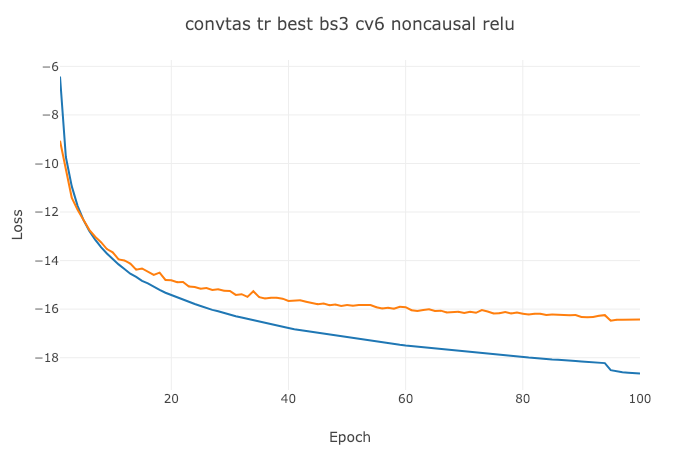A PyTorch implementation of Conv-TasNet described in "TasNet: Surpassing Ideal Time-Frequency Masking for Speech Separation".
| From | N | L | B | H | P | X | R | Norm | Causal | batch size | SI-SNRi(dB) | SDRi(dB) |
|---|---|---|---|---|---|---|---|---|---|---|---|---|
| Paper | 256 | 20 | 256 | 512 | 3 | 8 | 4 | gLN | X | - | 14.6 | 15.0 |
| Here | 256 | 20 | 256 | 512 | 3 | 8 | 4 | gLN | X | 3 | 15.5 | 15.7 |
- PyTorch 0.4.1+
- Python3 (Recommend Anaconda)
pip install -r requirements.txt- If you need to convert wjs0 to wav format and generate mixture files,
cd tools; make
If you already have mixture wsj0 data:
$ cd egs/wsj0, modify wsj0 data pathdatato your path in the beginning ofrun.sh.$ bash run.sh, that's all!
If you just have origin wsj0 data (sphere format):
$ cd egs/wsj0, modify three wsj0 data path to your path in the beginning ofrun.sh.- Convert sphere format wsj0 to wav format and generate mixture.
Stage 0part provides an example. $ bash run.sh, that's all!
You can change hyper-parameter by $ bash run.sh --parameter_name parameter_value, egs, $ bash run.sh --stage 3. See parameter name in egs/aishell/run.sh before . utils/parse_options.sh.
Workflow of egs/wsj0/run.sh:
- Stage 0: Convert sphere format to wav format and generate mixture (optional)
- Stage 1: Generating json files including wav path and duration
- Stage 2: Training
- Stage 3: Evaluate separation performance
- Stage 4: Separate speech using Conv-TasNet
# Set PATH and PYTHONPATH
$ cd egs/wsj0/; . ./path.sh
# Train:
$ train.py -h
# Evaluate performance:
$ evaluate.py -h
# Separate mixture audio:
$ separate.py -hIf you want to visualize your loss, you can use visdom to do that:
- Open a new terminal in your remote server (recommend tmux) and run
$ visdom - Open a new terminal and run
$ bash run.sh --visdom 1 --visdom_id "<any-string>"or$ train.py ... --visdom 1 --vidsdom_id "<any-string>" - Open your browser and type
<your-remote-server-ip>:8097, egs,127.0.0.1:8097 - In visdom website, chose
<any-string>inEnvironmentto see your loss
$ bash run.sh --continue_from <model-path>Use comma separated gpu-id sequence, such as:
$ bash run.sh --id "0,1"- When happened in training, try to reduce
batch_sizeor use more GPU.$ bash run.sh --batch_size <lower-value> - When happened in cross validation, try to reduce
cv_maxlen.$ bash run.sh --cv_maxlen <lower-value>